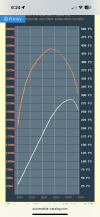If your diffs new diffs fit physically.
Your torque converter will spend more time out off lockup. That will result in more heat in your atf fluid so a slight decrease in atf fluid lifetime.
Then higher cylinder pressures. It will take x amount of energy to move the car down the road at a certain speed. In order for your engine to produce x amount of energy but at lower rpm it will have to output more torque. Torque is directly related to cylinder pressure. So if your rpm drops by 20% your torque will go up by 20% for the same amount of energy output. If your torque is up by 20% that means cylinder pressure is up by 20%.
Thats not taking into account that engine efficiency changes with rpm so at low rpm you usually have bad efficiency then where the engine makes peak torque you have peak efficiency and then efficiency gets worse again as rpm increase.
So if you drop your engine rpm too far below your peak torque rpm your cylinder pressure will have to be even higher than 20%.
You said: "If your diffs new diffs fit physically."
I have enough reason to believe they will fit based on the information that I have received here and another places.
You said: "Your torque converter will spend more time out off lockup."
The jury is still out on that. It depends on what input factors are used by the gearbox to make the decision to engage or disengage the lock up clutch. So far no one has been able to find the answer to this question.
I will be able to check this with my OBD reader so I can see if this is a problem or not before I leave on the trip. If it is a problem I will go back to the original differentials.
You said: "Then higher cylinder pressures. It will take x amount of energy to move the car down the road at a certain speed."
I am sorry but I do not agree. Running in a higher effective gear ratio will create a fuel saving on the trip. Like any time you drive in a high gear. Try driving on the highway in third gear for a month and then you will see your fuel consumption go up.
That is part of the reason why Range Rover moved to a six speed gearbox and eventually an eight speed gearbox for these cars, and moved away from the four speed in the P38.
If I am burning less fuel then I am creating less energy then I cannot be creating more pressure inside the cylinder. Where does this pressure come from if not from the energy of the fuel? By burning less fuel I am spending less energy and creating less pressure.
Maybe this change will not cause a saving in fuel, if the engine was lugging at low RPM, but I will not be not running in a low RPM. I think people somehow calculated that I will be running at 500 RPM or something like that, but it will be running well over 1,000 RPM for most of the trip. I have not calculated the exact RPM and I really don't care to do that but you are welcome to make the calculation.
You said: "Thats not taking into account that engine efficiency changes with rpm so at low rpm you usually have bad efficiency then where the engine makes peak torque you have peak efficiency and then efficiency gets worse again as rpm increase."
With the VANOS system this engine has a relatively straight torque curve from 1,000 RPM to 3,500 RPM. I will be dealing in the 1,000 RPM to 2,000 RPM range so it won't matter in terms of efficiency where in that rev range I am driving.
You said: "So if you drop your engine rpm too far below your peak torque rpm your cylinder pressure will have to be even higher than 20%."
At 70 mph I will be driving at an engine RPM that would normally be experienced when driving at 50 mph so well within the normal operating parameters of the engine.
The only time the RPM would be low is driving away from rest. Given that 90% of this trip will be driving on highways across Europe this will be a very small part of the trip.
As my car will be low in weight this will still be in the operating parameters of the car, given that the car is designed to be able to tow more than 100% of its weight.
If I was doing this and towing a caravan and four people in the car then that would be a completely different situation.
This is more like somebody putting larger off-road tires on the car, and I have seen no conversations about how that would cause a multitude of problems with this engine.
The torque and power curves of this engine are in the image below and I can see no significant issue based on this chart.


